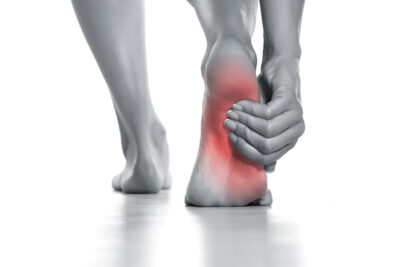PLANTAR FASCIITIS
Plantar Fasciitis involves inflammation of a particular weblike ligament called the plantar fascia. The plantar fascia ligament runs across the bottom of your foot and connects your heel to your toes.
Plantar Fasciitis is one of the most common causes of foot pain, about 10% of people will experience plantar fasciitis at some point in their lives. And if you’ve been in that 10% you know just how painful and debilitating this condition can be. That’s why we’ve devoted special attention to this painful condition and have cultivated years of holistically managing plantar fasciitis.
WHAT IS PLANTAR FASCIITIS?
Plantar fasciitis causes a stabbing pain in the bottom of your heel. The pain is most severe when you take your first steps in the mornings and usually decreases with movement throughout the day. So, if you suffer from plantar fasciitis, you probably dread those first couple steps each morning. Then, as you go about your day the pain may return after long periods of standing or your first steps after sitting for a while.
WHAT CAUSES PLANTAR FASCIITIS?
The plantar fascia supports the arch of your foot. It absorbs shock when you walk. Sometimes tension and stress on the ligament become too great. This tension on the fascia causes small tears, which then leads to scarring on your plantar fascia ligament.
As the stretching and tearing continue, your fascia becomes irritated and inflamed. Although the exact causes of inflammation are unclear, there are several risk factors for developing it. These risk factors can include:
- Being overweight, especially if you have a sudden weight gain, can be a risk factor due to the increased pressure on the plantar fascia.
- Occupations and hobbies that involve overuse of the plantar fascia are another risk factor because this adds significant stress and tension to the fascia. People who spend a lot of time on their feet, like restaurant servers and long-distance runners, can risk overusing the plantar fascia.
- Structural foot problems, such as very high arches, flat feet, or tight Achilles tendons (the tendons that attach your calf muscles to your heels), may also cause plantar fasciitis.
The good news is that some of these risk factors can be reduced through lifestyle changes. In some cases, very simple changes are enough to create significant improvement in plantar fasciitis symptoms. Other times, a robust treatment plan is needed to address symptoms and increase the quality of life of those suffering.
WHAT ARE THE SYMPTOMS OF PLANTAR FASCIITIS?
The major complaint with this condition is pain at the bottom of the foot near the heel or midfoot area. It generally affects just one foot at a time, but it can occur in both feet.
Pain from plantar fasciitis generally develops gradually. The pain can be dull or sharp and is usually worse in the mornings when you get out of bed and take your first steps or when you get up after sitting or lying down for a while. The pain doesn’t typically surface during exercise but often does afterward from the pressure and movement experienced during exercise, which causes further inflammation.
Because the pain doesn’t come on suddenly, it might be easy to ignore at first. But if left untreated, the plantar fascia can rupture, causing acute foot pain and significant swelling. So don’t put off treatment for your plantar fasciitis.
WHAT ARE THE TREATMENT OPTIONS FOR PLANTAR FASCIITIS?
If you’re suffering from this condition, the good news is that most people with plantar fasciitis can recover in several months with conservative, non-invasive treatments.
Resting, icing the area, and stretching are all very helpful to ease the inflammation that’s causing pain. For immediate relief, over-the-counter anti-inflammatory drugs, such as ibuprofen and naproxen, may ease some ligament pain.
At OC Wellness Physician Medical Group, we aim to not only ease your immediate pain but also prevent future pain from occurring and disrupting your life.
Our team of experts will create a plan to treat the underlying cause of the irritation and prescribe a protocol of in-office treatment and at-home stretches and exercises to ease pain and reduce inflammation.
Your individualized treatment plan may incorporate various modalities to get your best results as quickly as possible. Your plan may include:
- Chiropractic Care – using precise techniques and adjustments of the feet, ankles, and spine to get your body aligned and functioning properly.
- Physical Therapy – using exercises to stretch your plantar fascia and Achilles tendon and strengthen your leg muscles can help stabilize how you walk, lessening the pressure on your plantar fascia.
- Massage Therapy – using massage can ease the tension in your muscles and tendons and give relief to your plantar fasciitis pain.
- Acupuncture – the insertion of thin needles through the skin at strategic points can help treat pain.
Depending on your case, we may recommend wearing a splint at night that stretches your calf and the arch of your foot while you sleep. Or we may prescribe custom-fitted arch supports (orthotics) to help distribute even pressure to your feet. Also try Laser Treatment for Plantar Fasciitis Pain.
If you’re struggling with plantar fasciitis, you’ve been suffering long enough. We understand how initially seeking treatment for such a painful condition may be unfamiliar, but we’re committed to working with you on your treatment plan and guiding you through the entire process.
We want to help you get back to doing what you love – whether that’s playing pickleball on the weekends again, or finally getting to return to work. Our expert and compassionate staff at OC Wellness Physician Medical Group is here to offer effective treatments to get you back on the path to pain-free walking!

